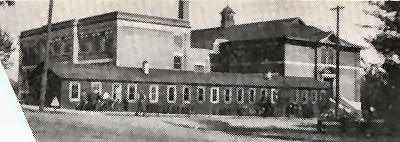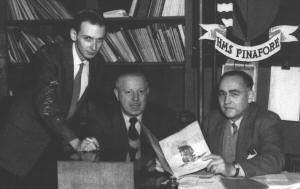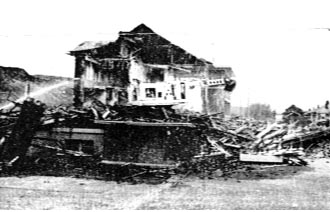 |
 |
 |
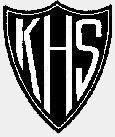
|
History of Kam HighThe Early Years: 1904 – 1952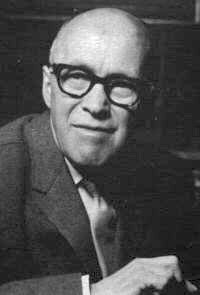 The story of the early years could not be told without the dedication and work of J. J. "Jock" Morse, a former teacher and counselor who, during his lifetime, was a tireless volunteer, historian and promoter of students and staff members. Sources of information for the early years include three booklets written by Jock: Kamloops the Hub and Schools and Scholars, published by Kamloops Secondary Resource Centre, and Kamloops the Inland Capital published by the Kamloops Museum. Other valuable sources used were Kamloops A History of the District up to 1914, by Mary Balf, which was published by the Kamloops Museum Association, and a number of unpublished articles by Mary Balf, which are available at the Kamloops Museum and Archives. Yearbooks prepared by students over the years and made readily accessible through the efforts of Walter Harder, were a great source of information and pictures. Kamloops Museum and Archives staff members Elisabeth Duckworth and Susan Cross, both former KSS students, provided much assistance in helping access the many pictures and articles about KHS/KSS contained in the Archives. During the fur trade era, Hudson's Bay factors and the clergy provided some education to young employees and the children of employees. As settlers moved into the area, a few families were able to capably teach their children and a few of the more wealthy settlers were able to send their children to Victoria or other cities. The majority of children however, received no formal education.
The first school in Kamloops, a privately owned school, was opened in 1878 by Nellie Roper, in her home, which was located just behind the old Dominion Hotel and later moved adjacent to Peterson Creek. Mrs. Roper accepted boarding pupils. In 1882, as a result of objections by her husband, Tom Roper, the school was closed. The first permanent school, a residential school for girls, was known as St. Ann’s Academy and was located on Mission Flats close to where the Weyerhaeuser Office building now stands. In 1881, a boys' school was built near St. Ann’s and was named St. Louis College. When the two schools were built, it was expected that the town would expand west of the Hudson’s Bay Fort, then located where the City of Kamloops Public Works department is now located. With the coming of the railroad in 1885, expansion took place in the opposite direction. Not only were the schools located poorly in relation to the expanding town, school grounds flooded during the annual spring high water. In the spring of 1887, it was decided to move the school(s) to town. The boys' school, which had not flourished as well as the girls', was demolished, and the St. Ann’s building was placed on a huge raft and floated up the river and located on property just west of the new town. The school served both boys and girls with boarding provided for girls only. By 1910 the attendance at the school had outgrown the buildings and a new site was secured and a three-story building constructed on the south side of Columbia Street. This building was the scene of a major fire on May 5th, 1945. It was necessary to demolish the third story. The remainder of the building was renovated, and with subsequent modernization and expansion, the building continues to provide education services. In 1885, the Department of Education decided that a public school in Kamloops was not necessary, and instead determined that a one room school should be built in Rayleigh, twelve miles from the town.
By 1907, the school had become inadequate and a new eight-roomed brick building was constructed, which was later named Stuart Wood School. Kamloops High School is Born — 1904Kamloops School, by the turn of the century, offered education up to grade 8. Secondary education, at the time, included grades 9 to 11. Pupils were required to write government exams at the end of grade 8 and at the end of grade 11. Community leaders believed that provision should be made for secondary education. Kamloops, having lost out on the hope of becoming the capital of BC, hoped to become the cultural and educational centre of the province. To this end, a number of local businessmen organized a joint stock company called 'The Kamloops College Company'. The college offered courses leading to university entrance as well as art and commercial programs. Although 31 pupils enrolled as fee-paying students, expenses exceeded income and the college closed its doors in 1904. Meanwhile, the Kamloops School Board realized the need for a publicly funded secondary school program and employed Mr. A. Perry, B.A., as the teacher in 1904. The school operated in the old Oddfellows’ Hall building which was moved from Victoria Street to First Avenue (just south of what is now the Klapstock building.) The lower floor was a livery stable, with the High School functioning upstairs. Twenty pupils were enrolled; one of whom, M. Leighton Wade, often spoke to KSS assemblies in the 1980’s. Mr. F. F. Smith had succeeded Mr. Perry as high school principal in 1906. In 1907, with high school enrolment at 35, the high school program was moved to the attic of the new Kamloops School located on Third Avenue. The wood-framed Kamloops School, a four-room school which had been located on the north-east corner of the property currently occupied by Stuart Wood Elementary School, was dismantled by dividing the building into four sections. One section became part of the original Hillikers Feed and Seed store in the 200 block of Victoria Street. Another section became a warehouse for Wilcox Hall, later called Marshall Wells, and the other two sections became garages; one at Third and Lansdowne Street and one at Third and Seymour Street. 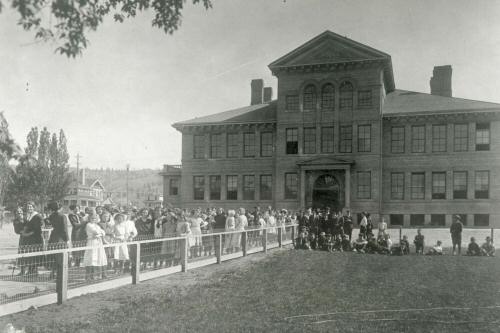
The new Kamloops School officially opened its doors to pupils on September 9, 1907. Elementary classes, grades 1 to 8, were offered in classrooms on the first two stories and grades 9 to 11 in the third story, commonly referred to as “the attic”. By 1909, the high school population had increased to 53 and the elementary population to 330. Such was the population expansion of Kamloops that the combined elementary and secondary population reached 403 in 1910. Kamloops School was overcrowded. Due to poor health, Mr. Wood resigned as principal and Mr. A. F. Matthews became the principal of both the high school and elementary programs. To alleviate crowded conditions, in January 1910, high school programs were moved to temporary quarters in the Methodist Church which was located at Third Avenue and Seymour Street (where the downtown Post Office Building is currently located). In 1912, the Board called for plans for a high school building. There were to be eight classrooms, a room for the School Board, Principal’s office, library, recreation room downstairs and an auditorium to seat 500 people. Plans called for a separate building to house a gymnasium; however, the cost of the total building(s) was considered too great and the plan was revised. The auditorium and the gymnasium were eliminated. The City agreed to pay 40% of the $60,000 cost of the building. The City of Kamloops provided the property which was to revert to the City when it was no longer required for use as a school.
In 1917, four typewriters were purchased and a secretarial program was introduced, to be taught by Miss McLean. In 1920, during the influenza epidemic, which greatly affected most of Canada including Kamloops, the schools were closed and the High School was organized as an emergency hospital. The building of the High School provided only temporary relief to schools being overcrowded. School population continued to increase rapidly; 414 students in 1912, 513 in 1915, 700 in 1920, and over 900 in 1921. Some rooms in the High School were converted into elementary classrooms and some elementary classes, for students who lived east of Fifth Avenue, took place in the Old Courthouse on the corner of First Avenue and Victoria Street and one class was in a commercial building on the south-east corner of First and Victoria. Plans were drawn up in 1921, for the building of a four-room elementary school and these plans were expanded to eight rooms before the school opened in September1922. A contest was held to name the two elementary schools. The prize was divided between Dorothy Matthews and Alice Power who both suggested 'Lloyd George School' for the new school and 'Stuart Wood School', the new name for what had been Kamloops Public School. In 1924, Senior Matric, grade 12, was introduced. Before 1924, grade 11 was considered high school graduation. In 1924 grade 12 became the last year of high school. To graduate, a student had to pass government exams. Students also wrote government exams at the end of grade eight in order to qualify for high school. The Putnam/Weir Survey, which was conducted by the Department of Education in 1924, suggested School Boards consider implementing Home Economics and Manual Training courses. The study also recommended a number of changes to education including the dropping of grade eight provincial examinations and streaming students into a university stream and a commercial stream.
In 1939 “Bill” Gurney was appointed principal. Throughout the 1930s and 1940s, KHS’s reputation for excellence in academics, athletics and the fine arts was expanded and enhanced. The accomplishments of students were impressive. With the outbreak of World War II in September 1939, many Kamloops High School teachers and students volunteered for military service. They served their country with distinction and honour. Many, unfortunately, paid the supreme sacrifice of losing their lives so that others might live in freedom. Cadet Corps became an integral part of school life, as did collections of materials to help the war cause. Students marched to and from Physical Education classes, which were held in the Kamloops Athletic Association Gymnasium which was located on Victoria Street (where the David Thompson Hotel is now located).
While the population of Kamloops increased very little during the war, there was great expectation that it would soon increase when the troops came home. Many so called "war time" houses were constructed east of Ninth Avenue, and in an area that was to become known as Valleyview. Physical Education classes continued to be held in the KAA Hall or, in good weather, on Cowan’s field. During the 1940s and 1950s, the Red Devil and Red Angel basketball teams gained provincial recognition and reputations as strong teams. Basketball and other extra curricular sports activities used the KAA Hall as their venue.
The Cameron Commission, a major study of education in B.C., reported to the Government in 1945 and recommended a number of changes which had implications for Kamloops High School. The number of school districts in BC was to be reduced from 830 to 74. Secondary schools were to offer a General Program as well as a University Program.
Some of the features to be included in the new High School were to be an auditorium capable of seating over 700 people, a full size gymnasium, a dormitory. The dormitory was built to accommodate rural students who lived in remote parts of the district and those from nearby districts which felt they could not provide a complete program within the new comprehensive education expectations of the Department of Education. Plans to bus students from throughout the expanded district were developed. Full cafeteria facilities and services had to be made available for students living in residence, as well as providing lunches for those who traveled great distance by school bus. Improved Home Economics, Industrial Education and Science laboratories were to be included, as was a full sized gymnasium. The price tag was well over one million dollars and required local approval by taxpayers at a referendum. Great was the disappointment of the Kamloops Jr. Sr. High School staff and students when the referendum failed to pass in 1948. On the second attempt, with the inclusion of upgrades to rural schools and less emphasis on building an auditorium, which many citizens regarded as being extravagant, the referendum to provide funds for the school passed in 1951 and construction began. The school was officially opened in 1952. Many people at the time thought the school was too far out of town and that the idea of bussing students from communities as far away as Westwold and Savona would not work. The auditorium was not added until one year after the new school was built.
See KHS /KSS in the Munro Street building 1952 to 2003 Epilogue - The St. Paul St. BuildingAfter the new high school opened in 1952, the old high school building became Allen Matthews Elementary School, named after Allen Matthews (School Inspector). It remained an elementary school until June 1980 when it was closed as an elementary school. From 1980 to 1989, the building was used by Cariboo College (now Thompson Rivers University). In 1989, the building was demolished. The land now houses the Kamloops RCMP Detachment. |
| Top of page | Site designed and maintained by Walter Harder & Associates |

 The first Superintendent of Schools for the newly formed province of BC, John Jessop, visited Kamloops in 1872. He met with settlers of the Kamloops area and it was agreed that the government should provide some schooling for the estimated 200 children who lived in the "upper country" of BC. It was suggested that a boarding school was needed and that it should be located in Kamloops. Superintendent Jessop's report was shelved until 1874, when Charles A. Semlin, the MLA for Yale and later a premier of BC, was able to persuade the legislature to build the school in Cache Creek, his home town. Mr. Semlin successfully argued that Cache Creek was at the cross roads between the Cariboo wagon trail and the Hudson's Bay route to Kamloops and the interior. The school opened in 1875 as a boarding and day school with pioneer, William Jones in charge. A number of children from Kamloops attended this school. The location of the school was on the site now occupied by Hungry Herby's restaurant.
The first Superintendent of Schools for the newly formed province of BC, John Jessop, visited Kamloops in 1872. He met with settlers of the Kamloops area and it was agreed that the government should provide some schooling for the estimated 200 children who lived in the "upper country" of BC. It was suggested that a boarding school was needed and that it should be located in Kamloops. Superintendent Jessop's report was shelved until 1874, when Charles A. Semlin, the MLA for Yale and later a premier of BC, was able to persuade the legislature to build the school in Cache Creek, his home town. Mr. Semlin successfully argued that Cache Creek was at the cross roads between the Cariboo wagon trail and the Hudson's Bay route to Kamloops and the interior. The school opened in 1875 as a boarding and day school with pioneer, William Jones in charge. A number of children from Kamloops attended this school. The location of the school was on the site now occupied by Hungry Herby's restaurant.
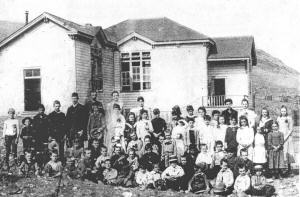 The continued efforts of residents of Kamloops paid dividends when in 1886, the Department of Education agreed to build a school in Kamloops. The Department appointed Stuart Wood as teacher. The new Board of Trustees for Kamloops selected a site and the Department provided $2,265; $1605 for the building, $600 to pay the teacher/principal and $60 for other expenses. Nine pupils enrolled in temporary quarters in Jim Guerin’s blacksmiths shop, in the 300 block West Victoria Street. On October 1, Kamloops School was completed and Mr. Wood and his pupils moved to the new school located on the west side of First Avenue between what are now Seymour and St. Paul Streets. The building was expanded in 1887, as the school population had grown to 78 pupils. By 1893, with an enrollment of 140, the Board decided that the school had outgrown not only the building, but also the site. A new four-room school was planned and built on the corner of St. Paul Street and Third Avenue. The original school building on First Avenue was renovated and served for a number of years as the Land Registry office.
The continued efforts of residents of Kamloops paid dividends when in 1886, the Department of Education agreed to build a school in Kamloops. The Department appointed Stuart Wood as teacher. The new Board of Trustees for Kamloops selected a site and the Department provided $2,265; $1605 for the building, $600 to pay the teacher/principal and $60 for other expenses. Nine pupils enrolled in temporary quarters in Jim Guerin’s blacksmiths shop, in the 300 block West Victoria Street. On October 1, Kamloops School was completed and Mr. Wood and his pupils moved to the new school located on the west side of First Avenue between what are now Seymour and St. Paul Streets. The building was expanded in 1887, as the school population had grown to 78 pupils. By 1893, with an enrollment of 140, the Board decided that the school had outgrown not only the building, but also the site. A new four-room school was planned and built on the corner of St. Paul Street and Third Avenue. The original school building on First Avenue was renovated and served for a number of years as the Land Registry office.
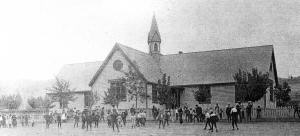 The Kamloops School on Third Avenue was a four-room school and was located on what was then the eastern edge of the town of Kamloops. Everything east of Second Avenue was considered East Kamloops. To this day, there is a bend in the road of all streets south of Columbia, between what was known as East Kamloops and what was known as West Kamloops.
The Kamloops School on Third Avenue was a four-room school and was located on what was then the eastern edge of the town of Kamloops. Everything east of Second Avenue was considered East Kamloops. To this day, there is a bend in the road of all streets south of Columbia, between what was known as East Kamloops and what was known as West Kamloops.
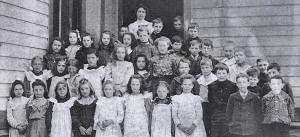 In the late 1890s, the writer’s grandmother, Katie Furness, having recently moved from Salt Spring Island where she had been employed as a teacher, joined Stuart Wood’s staff as a teacher at Kamloops School. She continued teaching at the School until 1905, when she married Walter George Lloyd and began raising a family. Most teaching then was “rote learning.” Spelling, Mental Arithmetic, Grammar, English and Canadian History, Elocution, and Writing were important subjects with greater weight placed on them than on Reading when it came to examinations. Reading was taught primarily by oral reading, with each pupil taking a turn. Class sizes in those days are reported to have exceeded 80 pupils.
In the late 1890s, the writer’s grandmother, Katie Furness, having recently moved from Salt Spring Island where she had been employed as a teacher, joined Stuart Wood’s staff as a teacher at Kamloops School. She continued teaching at the School until 1905, when she married Walter George Lloyd and began raising a family. Most teaching then was “rote learning.” Spelling, Mental Arithmetic, Grammar, English and Canadian History, Elocution, and Writing were important subjects with greater weight placed on them than on Reading when it came to examinations. Reading was taught primarily by oral reading, with each pupil taking a turn. Class sizes in those days are reported to have exceeded 80 pupils.
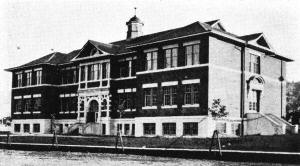
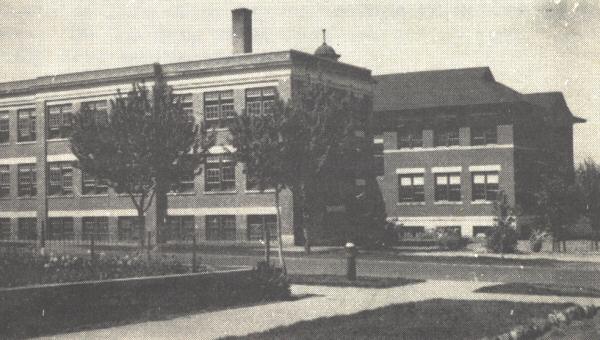
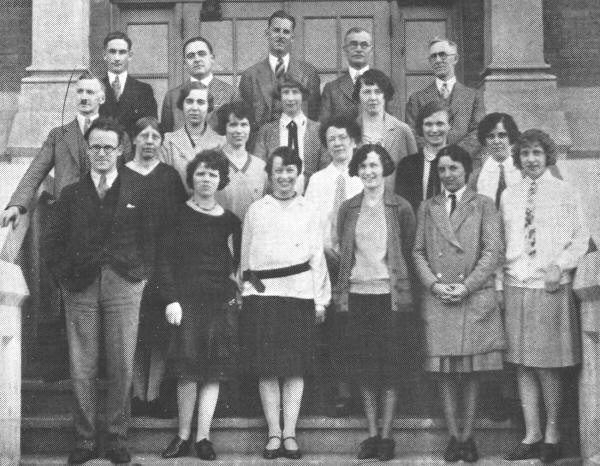
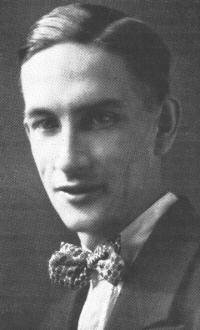 In 1929, Dr. J. F. K. English became the principal. The Board continued to hire capable and well qualified teachers. Many became legends unto themselves. Pictures of former staff members are available for each year in the
In 1929, Dr. J. F. K. English became the principal. The Board continued to hire capable and well qualified teachers. Many became legends unto themselves. Pictures of former staff members are available for each year in the 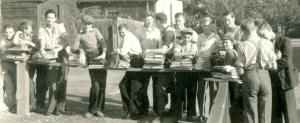 Those who attended the school during the 1940’s and 1950’s recall marching to the KAA Hall. If the marching was not precise enough, students were marched back to the school and required to repeat their performance until they got it right. Those who managed to "skip out" by dropping out of the parade and slipping into the bowling alley or Billiard Parlor, might end up visiting Mr. Chris Wright, a KHS teacher who was appointed vice-principal in 1943.
Those who attended the school during the 1940’s and 1950’s recall marching to the KAA Hall. If the marching was not precise enough, students were marched back to the school and required to repeat their performance until they got it right. Those who managed to "skip out" by dropping out of the parade and slipping into the bowling alley or Billiard Parlor, might end up visiting Mr. Chris Wright, a KHS teacher who was appointed vice-principal in 1943.
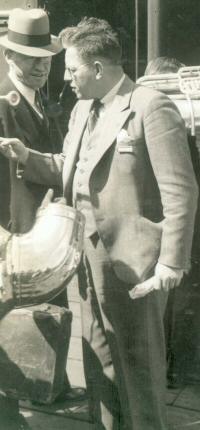 Archie McMurdo returned from overseas and enrolment in his popular music programs was so great that arrangements were made to use the old Colombo Hall on Seymour Street as a music room. The Junior Symphony, sponsored by the Kamloops Legion and conducted by Mr. McMurdo, became well known. Mr. McMurdo inspired many students to excel in music. Countless others developed, through his leadership, a life long appreciation for, and love of, music. The Kamloops High School band won local, provincial and international recognition for excellence. Band and Orchestra trips were an exciting part of school life for many students. Major musical productions became highlights of each school year, as did individual and group performances in Music Festivals.
Archie McMurdo returned from overseas and enrolment in his popular music programs was so great that arrangements were made to use the old Colombo Hall on Seymour Street as a music room. The Junior Symphony, sponsored by the Kamloops Legion and conducted by Mr. McMurdo, became well known. Mr. McMurdo inspired many students to excel in music. Countless others developed, through his leadership, a life long appreciation for, and love of, music. The Kamloops High School band won local, provincial and international recognition for excellence. Band and Orchestra trips were an exciting part of school life for many students. Major musical productions became highlights of each school year, as did individual and group performances in Music Festivals.
